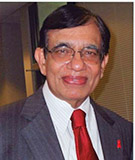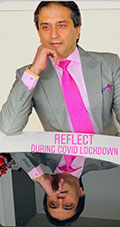
Corona Virus Pandemic: Part IX
Dealing with Mental Health issues

During the past several months, we have talked about only one thing – coronavirus pandemic and the chaos it has inflicted on us! The newspaper headlines continue to give us alarming news about the virus. The infection rate is increasing and hospitalizations are at an all time high. The total number of cases in the U.S. has now topped 25 million with deaths approaching 425,000! And the prediction is that the total deaths could go up to 500,000 by mid-February.
So, when is this pandemic going to end? That will happen only if 80-90 percent of the population get vaccinated and sufficient herd immunity is established. All states and counties have now received a certain number of doses and hope everybody is making an attempt to register and get vaccinated soon. I got my first dose and am waiting for the booster in three weeks. But right now, we have to handle the big surge of cases happening everywhere. It’s clear that prevention protocols are not followed strictly. Many countries in Europe have tightened restrictions and some have brought back the lockdown too. Here, we are encouraging everybody to observe a voluntary modified form of lockdown to curb the spread. But lockdown is not easy on anybody and confinement fears and anxiety are becoming part of our daily life, which is what I want to talk about.
One of my retired friends said: “How long do we have to endure this virus? I am getting anxious sitting cooped up in my apartment.” Yes, I could understand his anguish perfectly. Many studies have come out recently that showed the deterioration of mental health after the pandemic started. Yes, I too have my own psychological stresses and losing much sleep. I know a large swath of humanity is discouraged from leaving home still except for essential services. All of us are totally stressed out as we continue with this seemingly endless Covid-19 journey, not knowing when and how it is all going to end, if it ever ends at all. Now, there are new variants of the virus to content with and experts think it may take another year for the pandemic to subside.
So, instead of obsessing about, “I am stuck at home and bored,” focus on the many things you can do at home, creative and constructive, to keep yourself busy. Stay as close to your regular routine as possible. Many people are working from home happily. A follow-up visit with your doctor can be done through ‘tele-health.’ One of my friends has brushed up on his painting skills and is creating oil on canvas paintings. You can also try sketching and painting yourself. Or you can start writing; there is ample to write about – pen a poem or a story or about your own activity in a personal journal. There are plenty of Zoom meetings, webinars, podcasts and even live streaming concerts you can attend. Make use of your computer fully. Spend time in your backyard and spruce up your vegetable garden. Make sure you get plenty of exercise and enough sunshine. Regular exercise is good for the entire body, boosts your energy and enhances the immunity. Well, there are many ways to spend your time usefully.
It’s easy to get lost in anxiety and depression and wallow in your own misery. Keep in mind, human spirit has great powers of resilience and we can restore this strength by purposely focusing on healing of our own mind. I have now taken to meditation and 20 minutes every morning is reserved for this great practice and I feel I have found my personal sanctuary – my mind. In these difficult times, I remember my yoga teacher’s advice, “If equanimity is a priority, then meditation is the best path.”
Maintaining your social connections – social distancing doesn’t mean social isolation – through whatever ways you have available, getting out and enjoying nature, doing creative work in your own home … well, there are many more ways to restore peace and harmony in your life at this difficult time. The indomitable human spirit can and will transcend all adversities and restore peace and happiness in your life. As President Joe Biden said, “We will defeat this pandemic, help is on the way.” So hang in there folks, good days are around the corner.
To be continued …
M.P. Ravindra Nathan, M.D., is a cardiologist and Emeritus Editor of AAPI Journal. For further reading, “Second Chance - A Sister’s Act of Love” by Dr. Nathan from Outskirts Press, can be found at www.amazon.com
Eye Care
Age-Related Macular Degeneration (AMD): There is Hope!

Let’s revisit the anatomy of the eye to better understand macular degeneration.
I like to explain the retina (previous Khaasbaat article) as the “film” of the camera which lies at the back of our eye and is made up of ten layers that help light to be processed into signals so we can see. The most sensitive visual point of the retina is called macula.
Over time, with age and with other associated factors like genetic preponderance, smoking, systemic diseases, including high blood pressure, etc., this macular area, which is the center of our visual field, degenerates. Hence, affected patients miss the central part of any picture they are seeing. This condition called “age-related Macular Degeneration” or AMD is the leading cause of blindness in the United States.
February is National Age-related Macular Degeneration (AMD) Month, designated by the American Academy of Ophthalmology. It happens when the macula in particular is damaged causing loss of central vision and you can no longer see details at close or far and actually may see a large black spot in your vision with periphery being visible.
Among people above 50 years of age, AMD is the leading cause of blindness and presents in two forms:
Dry AMD
This form is quite common. About 80 percent (8 out of 10) of people who have AMD have the dry form. Dry AMD is when parts of the macula get thinner with age and tiny clumps of protein called drusen grow to damage central vision. This stage is considered to be early with no active treatment modality
Wet AMD
This type of AMD is less common but much more serious. Wet AMD is when new, abnormal blood vessels grow under the retina. These vessels may leak blood or other fluids, causing scarring of the macula. You lose vision faster with wet AMD than with dry AMD. There are treatment modalities available today, including intravitreal injections of special drugs that prevent new vessel growth.
Though age beyond 50 is a risk factor, other factors such as a diet high in saturated fat like meat and butter, being a Caucasian, overweight, smoker, hypertensive, heart disease, high cholesterol levels and positive family history do also contribute to increased incidence of the condition.
Cumbersome low vision aids, including high magnifying hand-held devices, have been used in such conditions to relatively magnify the image and help patients see around the defective area.
There is still hope
Even if you have AMD, as long as it is stable, I encourage patients to seek vision improvement surgeries so they can at least maximize their remaining capacity to see and be independent.
Most patients around 60 years of age do have early cataracts and also associated vision refractive errors. including near or farsightedness and astigmatism. I would encourage any patient who is noticing deterioration in vision to get it checked by eye doctors to determine status of cataracts and also stability of coexistent macular degeneration.
Surgery can then be offered not only for cataracts but also to correct your glasses prescription simultaneously to attain vision “optimized for your best brain potential” (LenzOplastique - Art of Cataract Surgery: KhaasBaat) using technological advances of lens implants from over 30 choices along with laser precision and tailored vision goals.
Additionally, the US. .FDA has approved a miniature telescope lens implant for patients with end stage macular degeneration that can be implanted during cataract surgery and in many cases even after.
Please do visit your eye doctor to check on the health of your eyes regularly once you are over 50 years of age and have them not only look for AMD but also for any potential to improve the vision once stable.
Arun C. Gulani, M.D., M.S., is director and chief surgeon of Gulani Vision Institute in Jacksonville. He can be reached at [email protected] or visit www.gulanivision.com